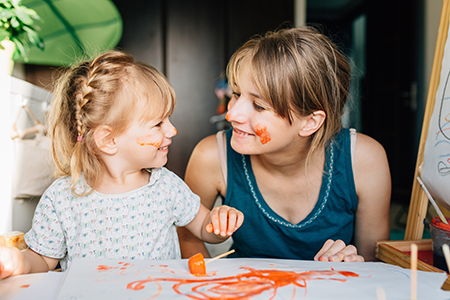
Art can open the mind and soothe the soul for people of all ages, so you’re probably not at all surprised at my proclamation that art is especially beneficial for the littlest among us. Yes, children can learn so much from art projects, and not just skills to become the next Picasso (or maybe, more accurately, Jackson Pollock.) Art activities can encompass so many early learning gems, so below are a few ideas to get you started.
But first, here’s a vocab word to add to your plate: process art. It’s really quite simple. The idea is that the art your child creates is more about the journey than the destination. It doesn’t matter if your kid’s artwork is a mess and falling apart (#relatable), because what really matters is the learning skills as your child creates. Moving fingers and grabbing materials builds fine motor skills. New textures and colors opens doors to new feelings and great conversations between you and your child. Not to mention that art can give children a sense of control over their creations and can let them take responsibility over the creative process. So as much as you can, let your child go wild and make creative decisions, even if it means a nice rainbow of paint becomes a gross brown blob, or a neat pattern of turns into abject chaos. If you find it difficult to resist guiding your child toward neater artwork, you might try doing the same project beside them as they do theirs. You can satisfy the craving to make something neat and tidy, plus you show your little one that grown-ups create art too. What’s more fun than making art together?
Get ready to make mistakes, make a mess and make memories!
Spaghetti Painting – Playing with cooked spaghetti is a hoot and half, but add washable paint, and your day is made. Use individual strands as brushes, swish around a whole messy pile onto paper or press paper on top of your mess to make a print to keep once the spaghetti is toast.
Painting Genius – Turn something that isn’t a paintbrush into a paintbrush. It’s a blast and gives those finger muscles a workout. Here are a few to try: cotton swabs, plastic forks, craft sticks, a cotton ball gripped in a clothespin, toy cars, building blocks—the list never ends!
Scribble – Scribbling is the first step to writing, so let your child scribble away into the sunset. Introduce different tools for coloring. Keep it simple with crayons and markers, or go wild with bath crayons, crayon wheels or DIY chunky crayons you can make by baking old crayons in a muffin tin.
Bubble Wrap Prints – Why paint directly on the paper when you could paint something else, then press that onto paper? Bubble Wrap has a great texture and makes interesting patterns that you can talk about with your little one. Make your own stamps out of household items—cut up rough old rags or dip the end of a TP roll into paint for an easy circle stamp.
Drip Painting – When painting on a flat surface gets boring, try letting gravity paint for you. Hang your paper on an easel, wall or table edge. Then all you need is a dropper and some paint diluted with water. Droppers are an excellent workout for the hands, and they make for a great gravity/science lesson too.
DIY Dough – There are dough recipes as simple as flour, salt, oil, water and kneading (and no baking) that you can make with your child. No need to worry about the art supplies venturing toward the mouth. Even if a recipe doesn’t work out, you can play with the textures, experiment, demonstrate measuring and mush ingredients around. If it works, you have a whole new art project ahead.
I’ll stop here, but the possibilities are as endless as your imagination. Go out there and get paint everywhere.


